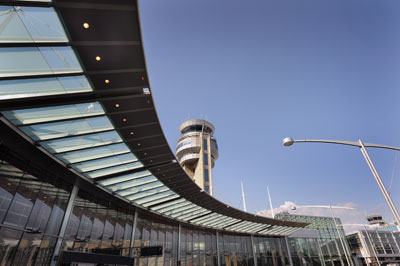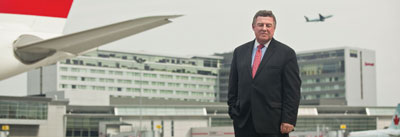
Features
Airports
AIRPORT INSECURITY
For what seems like an eternity, Canadian airport authorities have been hammering away at Ottawa and various municipalities to give them a break
January 12, 2012 By Brian Dunn
For what seems like an eternity, Canadian airport authorities have been hammering away at Ottawa and various municipalities to give them a break on rent, taxes and security charges among other costs, to keep Canadians from driving across the border for cheaper flights.
 |
|
| PHOTO: Aéroports de Montréal
|
The typical and rather blasé response from Ottawa, according to industry insiders, has been that additional fees on an airline ticket are not a major concern for most constituents so why should the government worry about it?
The truth of the matter is the industry is fighting an uphill battle. That was the clear message delivered to the recent annual general meeting of the Air Transport Association of Canada (ATAC) in Montreal in mid-November. To illustrate the cost burden, James Cherry, president and CEO of Aéroports de Montréal (ADM), threw out a few statistics just for Montreal-Trudeau alone. The airport supports almost 53,000 direct and indirect jobs, produces more than $4.5 billion of added value or close to four per cent of Montreal’s gross domestic product. Meanwhile, the feds collected $36.8 million in rent last year and ADM also had to cough up $37.9 million in municipal taxes, the highest in Canada. The net result was a deficit of $15.9 million for ADM which also runs little-used Mirabel Airport. Cherry estimates that 20 per cent of ADM’s revenue goes to covering these two expenses alone.
An International Air Transport Association (IATA) study calculates Canada’s entire aviation sector contributes $33.3 billion, or 2.2 per cent of GDP, and supports more than 400,000 jobs. Although airports are an economic engine, Cherry notes the feds charge them $300 million in rent annually and Ottawa has collected some $2.5 billion in rent since 1992. Moreover, Canada is losing ground as a tourist destination due the high cost of air travel compared to other countries, according to the National Travel and Tourism Coalition (NTCC).
So, what’s the solution? Fortunately for Canada, most U.S. states, municipalities and the federal government are broke, so a lot of the “freebies” that U.S. airports currently enjoy will likely disappear, according to Nick Mulder, senior associate of Global Public Affairs in Ottawa who worked for Transport Canada for 15 years where he was deputy minister. And other groups such as tourist and hotel associations are joining Canadian airports in their efforts to get Ottawa to level the playing field, adds Cherry.
Stunted growth
Mulder sees four major irritants that are holding the industry back. The first is governments are using the sector as a cash cow instead of an economic engine, collecting some $1 billion in special charges in 2011, over and above normal business taxes, in addition to $1.1 billion for NAV CANADA. “Passengers aren’t getting nickeled and dimed, they’re getting loonied and toonied, because extra charges are higher than the actual airfare,” says Mulder. “The result is people opt to fly from U.S. airports.”
 |
|
| James Cherry, president/CEO of Aéroports de Montréal (ADM), says Montreal-Trudeau airport supports almost 53,000 direct and indirect jobs.
|
A second irritant is out-of-date international air agreements. Mulder says. “Open Skies” agreements are more “cloudy skies” since they are not really open, because Canadian airlines can’t fly passengers between cities in the U.S. or Europe; similarly, U.S. or European airlines fly passengers between cities in Canada.
Foreign ownership restrictions is another area that is discouraging foreign investment in Canada’s air transportation sector. Foreign ownership is restricted to 25 per cent in Canada, which can be increased to 49 per cent in some special cases, but difficult to implement, Mulder notes. “In Latin America, airlines are allowed to buy or merge with other airlines. The same applies to Asia and Europe where Air France and KLM merged,” he argues.
The fourth irritant involves air security where passengers cover all costs and face major delays with the result that many opt to take the bus or train as an alternative. The consultant put forward some recommendations he hopes Ottawa will implement. The first would be to “reduce the financial burden on the industry and passengers over the next three years by striking a two-for-one deal.” In essence, for every dollar the government reduces airport rent, fees and taxes in the sector, passengers recoup 50 cents of the benefit.
“So, if airport rents are eliminated, airport improvement fees to passengers should then be reduced by 50 per cent,” he says. The same would apply to the elimination of the fuel excise tax and the government should fund at least half of all security costs. Canada should also negotiate “true” Open Skies agreements with other countries and support increased cooperation and integration among airlines. “North America is isolated,” Mulder says. “The rest of the world is moving towards Open Skies. Twenty years from now, they [North American carriers] may say they missed the boat.”
Mulder asserts that foreign ownership rules should also be changed or eliminated, a step that has been taken for most other industrial sectors. “It’s been done for car companies worldwide; why not airlines?” he asks. And in addition to reducing security charges for passengers, Mulder suggests body scanning should be based on passenger behaviour and not on random selection to simplify and speed up the process.
Mulder maintains these measures would optimize the potential for increased international traffic and enable Montreal, Toronto and Vancouver to become international hubs, as Dubai has. Mulder adds that the long-term positives emanating from his recommendations would “greatly outweigh any short-term negatives.”
A unique product offering
While many Canadian airport authorities are struggling to make ends meet, there is good news from at least one major Canadian carrier inhabiting them. With so many failures over the years, airlines have had a bad rap when it comes to attracting new sources of capital, according to Wings correspondent Ted Larkin of Larkinvest, Toronto, who also addressed ATAC’s annual meeting. Larkin says the trick is to be innovative in developing a unique product or service and to emphasize your strengths compared to the competition. He cites the example of Porter Airlines, which has developed a “hub fortress” at Billy Bishop Toronto City Airport, despite the arrival of Air Canada last May.
 |
|
| Foreign ownership is restricted to 25 per cent in Canada, which can be increased to 49 per cent in some special cases, but it is difficult to implement. That’s not the case in Europe, where Air France and KLM merged.
|
But as it grows its fleet and adds more destinations, Porter is moving away from its hub-and-spoke model. It already offers non-stop service between Ottawa-Halifax and Montreal-Halifax and soon may offer direct service between Montreal and such cities as New York Newark, Boston and Chicago without having to go through Toronto. And it is offering a new weekly seasonal service between Newark and Mont Tremblant, after Continental dropped the route this winter. Its next city pairing could well be Toronto-Washington, D.C.
“We’ve already got 172 of 202 slots or 85 per cent of the slots at Toronto Island and we hope to maintain that position,” says Porter CEO Robert Deluce. “But now we will refocus on our other three core cities of Montreal, Ottawa and Halifax. And Montreal-Boston, Montreal-Newark are also possibilities when Toronto is capped out.”
Deluce doesn’t feel Porter’s new seasonal service from Toronto to Burlington, Vt., will take business away from its Toronto-Tremblant service. “They’re two different markets and we offer 13 flights a week to Tremblant and only twice-weekly service to Burlington.”
But the addition of Burlington close to several ski resorts including Stowe, Smugglers Notch and Sugarbush, may induce Porter to offer packaged vacations as it considers expanding its fleet from 24 Bombardier Q400s to 30 over the next two years. “We’re looking at taking on packages (combining flights, hotel rooms, ground transportation and ski passes), because we have the technique with our new reservation platform. We’re currently discussing options such as this with partners to determine what is feasible,” Deluce adds. The company offered packages to Tremblant last winter and the move was very successful, according to the CEO. Porter is also in discussions with mainline carriers to enter into codeshare agreements to offer service to North American and international destinations.
The airline has been approached by both St. Hubert airport on Montreal’s south shore and Bromont airport in the Eastern Townships about the possibility of service to their respective communities. Deluce says Porter looks at all possibilities, but feels the airline is already well served by Montreal Trudeau and would likely increase frequencies to U.S. destinations before opening new routes in Canada. And despite the arrival of Air Canada in May at Billy Bishop, Porter continues to grow.
“We’re up 14 per cent since May and up 35 per cent from a year ago. It’s a win-win situation, because we get added revenue from them using some of our services and they get access to the airport. They’re also bringing in new traffic that never used the airport before and we hope to convert some of them to Porter customers.”
Deluce is also confident the airport may finally get U.S. Customs pre-clearance facilities, which could boost business to U.S. destinations. “We now have the critical mass to warrant it. The airport was ranked 14th largest in Canada at the beginning of the year and is now ranked ninth. But it’s a Homeland Security decision.”
Porter celebrated its fifth anniversary this past October, the same month it welcomed its five millionth passenger. It expects to carry two million passengers in 2012 alone. So, while some airports are struggling to find their way in a challenging environment, it’s refreshing to see some successes on the airline side of the equation.